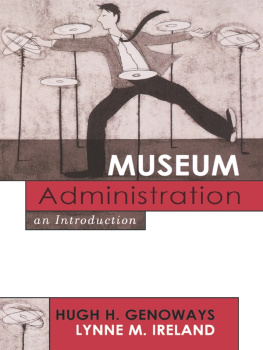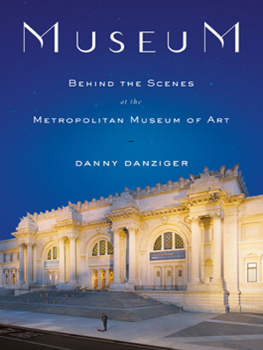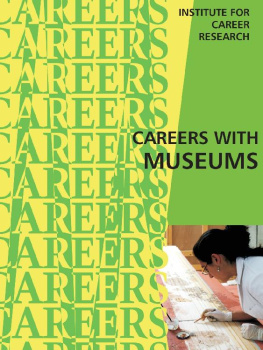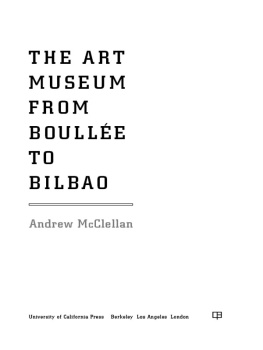Museums 101
Museums 101
Mark Walhimer
Rowman & Littlefield
Lanham Boulder New York London
Published by Rowman & Littlefield
A wholly owned subsidiary of The Rowman & Littlefield Publishing Group, Inc.
4501 Forbes Boulevard, Suite 200, Lanham, Maryland 20706
www.rowman.com
Unit A, Whitacre Mews, 26-34 Stannary Street, London SE11 4AB
Copyright 2015 by Rowman & Littlefield Publishers, Inc.
All rights reserved . No part of this book may be reproduced in any form or by any electronic or mechanical means, including information storage and retrieval systems, without written permission from the publisher, except by a reviewer who may quote passages in a review.
British Library Cataloguing in Publication Information Available
Library of Congress Cataloging-in-Publication Data
Walhimer, Mark, 1964
Museums 101 / Mark Walhimer.
pages cm
Summary: Looking for an AZ, one-stop, comprehensive book on museums? Wish you were able to have one of the nations leading museum consultants spend a couple of days with you, talking you through how to start a museum, how museums work, how to set up an exhibit, and more? If so, Museums 101 is the answer to your wishesProvided by publisher.
Includes bibliographical references and index.
ISBN 978-1-4422-3017-0 (cloth : alkaline paper) ISBN 978-1-4422-3018-7 (paperback : alkaline paper) ISBN 978-1-4422-3019-4 (electronic) 1. Museums. 2. MuseumsUnited States. 3. Museum techniques. I. Title.
AM5.W35 2015
069.0973dc23
2015002970
 The paper used in this publication meets the minimum requirements of American National Standard for Information SciencesPermanence of Paper for Printed Library Materials, ANSI/NISO Z39.48-1992.
The paper used in this publication meets the minimum requirements of American National Standard for Information SciencesPermanence of Paper for Printed Library Materials, ANSI/NISO Z39.48-1992.
Printed in the United States of America
For Anne, Les, Patricia, and Meg
Museums 101 Advisory Board
Jim DeMersman, Executive Director, Museum on Main, Pleasanton, California, United States of America
David L. Godfrey, C.P.A., Allison & Godfrey, Certified Public Accountants, Norwalk, Connecticut, United States of America
Van A. Romans, President, Fort Worth Museum of Science and History, Fort Worth, Texas, and Board of Trustees, American Alliance of Museums, United States of America
Sergey Solovyev, Ph.D., Department of Greek & Roman Antiquities, The State Hermitage Museum, Russia
Alison Spence, Exhibitions and Loans Registrar, National Museum of Australia, Canberra ACT, Australia
Audrey Vermette, Director of Programs and Public Affairs, Canadian Museums Association, Ontario, Canada
Acknowledgments
In 1985, I walked into the Phoenix Art Museum as a scared kid and asked to be a volunteer in the exhibits department. The next day, I was touring the galleries with the curator of the modern art collection. From that morning on, I was hooked. I am consistently impressed and thankful to everyone in the museum field for their generosity and willingness to share their knowledge.
Thank you to my familymy mother Anne Walhimer, sister Meg Joyce, and my wife Patricia Ochoafor their love and support. Thank you to my second family, Ron and Janice Dong, for their encouragement.
Thank you to Charles Harmon for believing in thinking differently about museums, to John Strand and Lindsay P. Mann for their tireless editing, and to the books advisory board for their knowledge and commitment to helping people new to the museum field understand the great resources that every museum provides for its community.
Mark Walhimer
Preface
To many people, museums are simply elegant storage buildings. But more than simple repositories or collections, museums represent an ideal. Each museum is a fully functioning organism that reaches visitors on an emotional level, both within the museums physical location and beyond.
Museums 101 covers the museum basics, including education and programming, collections management, fundraising, museum planning, museum governance, and exhibition design. This book explores how each of these distinct museum departments can work together to create a dynamic hub of communities built around collections.
There are a few traits that can describe the worlds best museums: a visitor-centric approach, a museum without walls, a sense of hospitality, an integrated museum approach with a distinctive voice. In this book, readers will come to understand fully each of these terms and will learn how to incorporate these practices into new and existing museums.
Museums 101 is structured in five parts:
I. Essential Museum Background
II. Creating an Integrated Museum
III. Exhibitions
IV. Behind the Scenes
V. The Museum Toolbox
This structure provides the reader with a basic understanding of the purpose of all museums. The book then leads the reader into the specifics of how to create an integrated museum culture that will support a specific museum mission. This is followed by the basic principles of operating a museum, and finally, creating the visitor experience. The last section of the book, the Museum Toolbox, is a chapter of quick facts, resources, and museum standard practices.
The sections and chapters of Museums 101 help readers launch a new museum or revitalize an existing one, while keeping in mind the fields recent paradigm shift toward visitor inclusion. While you can read this book cover to cover, you can also choose to read sections as you need them. If you have a question about fundraising, read the related chapter for an overview, then flip to the back to use the sample documents included. You can also review the Resources section, look up key words in the Glossary, and use the Index to find cross-references to other related topics.
Throughout the book, the word museum covers the entire spectrum of museums, including art museums, art centers, science centers, science museums, history museums, historic houses, natural history museums, childrens museums, visitor centers, aquariums, zoos, and botanic gardens. Not included in the scope of this book are art galleries (for profit), destinations (for profit), amusement parks, and librariesalthough many libraries now include museums.
My hope is that Museums 101 will begin many conversations and help advance the museum field. The storage, care, prescribed significance, and display of artifacts in the care of museums is ever more important as the boundaries between real and virtual blur.
This book is written for six distinct types of readers: museum founders, new museum staff and volunteers, those wishing to work in museums, new board members, students, and those wishing to contract services with a museum. In the Museum Toolbox are specific guidelines for each of the six types of readers.
All readers should understand the weight of responsibility that every museum has for educating the public, while respecting the existing and evolving museum culture. Even as things change in the profession and in society, museums still rank as the publics number one source of trusted information.
Mark Walhimer
Note
1. BritainThinks . (2013). Public survey commissioned by Museums Association, London, England. Perceptions of and attitudes to the purposes of museums in society. Accessed May 1, 2014, from http://www.museumsassociation.org/download?id=954916.
Griffiths, Dr. Jos-Marie and King, Donald W. (2008). InterConnections: The IMLS National Study on the Use of Libraries, Museums and the Internet . Commissioned by The Institute of Museum and Library Services. Accessed April 1, 2014, from http://www.interconnectionsreport.org/reports/IMLSMusRpt20080312kjm.pdf.
Lake Snell Perry & Associates, (2001), Nationwide public opinion survey commissioned by American Alliance of Museums.
Next page







 The paper used in this publication meets the minimum requirements of American National Standard for Information SciencesPermanence of Paper for Printed Library Materials, ANSI/NISO Z39.48-1992.
The paper used in this publication meets the minimum requirements of American National Standard for Information SciencesPermanence of Paper for Printed Library Materials, ANSI/NISO Z39.48-1992.